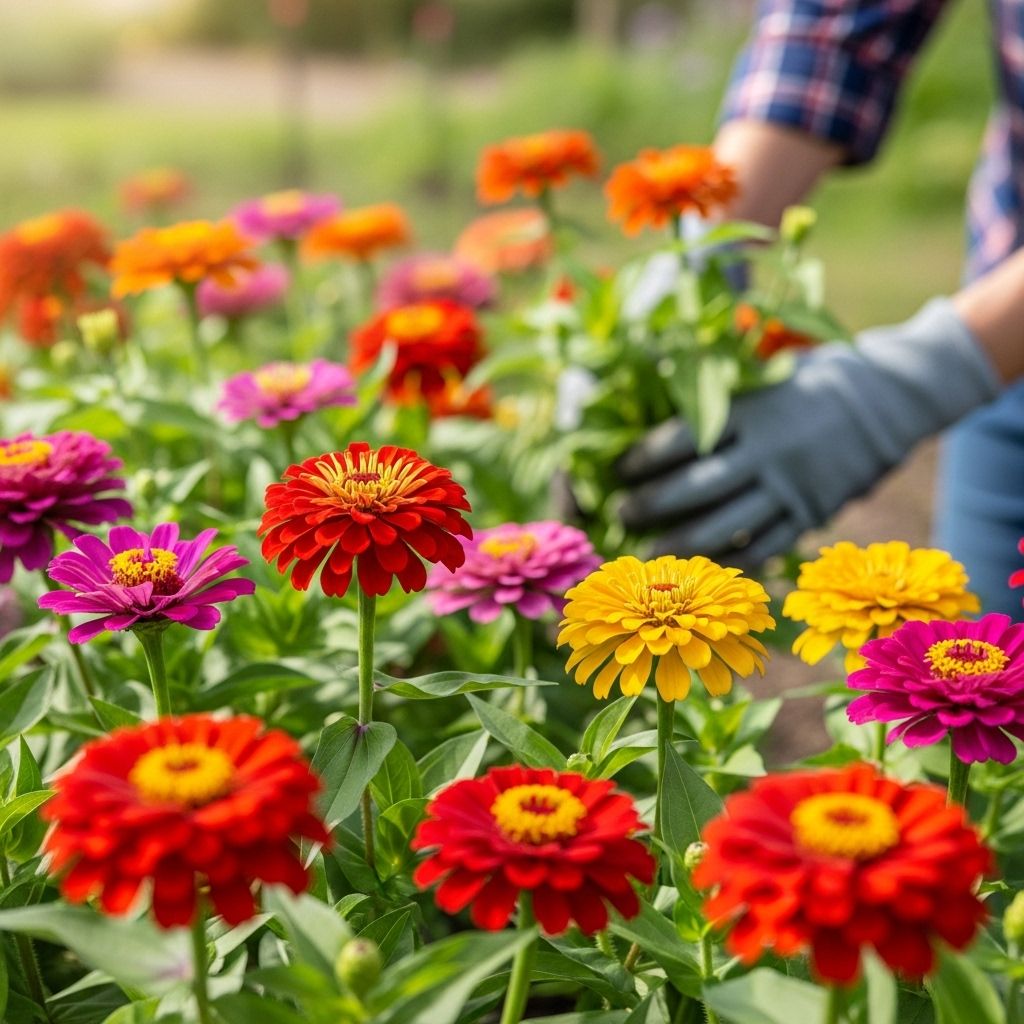How To Grow Zinnias: 5 Easy Steps For Vibrant Blooms
Discover the color, variety, and effortless beauty zinnias bring to your garden and floral designs.

Image: HearthJunction Design Team
Zinnias: Colorful Essentials for Any Garden
Zinnias have won the hearts of gardeners and floral designers alike, thanks to their dazzling array of colors, low-maintenance nature, and unrivaled ability to cut and come again through the summer. Whether you’re a seasoned green thumb or a curious beginner, zinnias offer a joyful, reliable source of blooms that are as stunning in the garden as they are in a vase.
The Allure of Zinnias
Zinnias (Zinnia elegans) are cherished for their bold, cheerful blossoms and remarkable adaptability. Native to the southwestern United States, Mexico, and Central America, their journey from inconspicuous wildflowers to beloved garden staples was shaped by centuries of cultivation and breeding. Today, zinnias are celebrated for:
- Vivid blooms in nearly every color except true blue.
- Wide range of flower forms (single, semi-double, double) and sizes, from petite 1-inch pompoms to dramatic 7-inch giants.
- Growth habits ranging from compact (6 inches) to towering (4 feet) plants.
- Butterfly and pollinator appeal with lasting cut-flower performance.
Why Grow Zinnias?
- Ease of Growth: Zinnias thrive in sunny locations, tolerate heat, and resist most common garden pests and diseases.
- Fast to Flower: Grown from seed, most varieties bloom within weeks and continue producing all season.
- Versatile Use: Perfect for filling garden beds, borders, containers, and bouquets.
- Pollinator Magnet: Bees and butterflies, especially, adore zinnias.
History and Origins
The humble beginnings of zinnias trace back to their wild ancestors: small, daisy-like flowers referred to as “mal de ojos” or “evil eyes” in Spanish. It was in the eighteenth century that the German botanist Dr. Johann Gottfried Zinn first documented the plant, earning the species its name. Zinnias surged in popularity in the early twentieth century when selective breeding produced now-iconic cultivars like ‘Giant Dahlia’ and ‘California Giant.’ These showy types propelled zinnias into the global gardening spotlight, resulting in the diverse palette of cultivars available today.
Popular Zinnia Varieties
With hundreds of cultivars available, there’s a zinnia for every taste and space. Some standout series and varieties include:
- Benary’s Giant: Known for enormous, double flowers up to 4-6 inches across, ideal for cutting.
- Oklahoma Series: Medium-sized, round blooms on strong stems with extraordinary disease resistance.
- Persian Carpet: Petite plants with profuse, bi-colored, semi-double blooms, perfect for borders and containers.
- Zahara and Profusion Series: Compact, mildew-resistant varieties that thrive in garden beds and containers, offered in a kaleidoscope of colors.
- Queen Series: Unique antique hues in rose, lime, and orange shades, excellent for sophisticated floral design.
Designing with Zinnias
Zinnias bring vibrant color, texture, and versatility to floral designs, making them a go-to flower for bouquets, centerpieces, and event arrangements.
Design Tips:
- Water Source: Zinnias need a constant water supply to stay fresh. Always use a vase, water tube, or water-absorbent base.
- Creative Combinations: Mix smaller types like Persian Carpet with larger Benary’s Giants for dynamic, layered arrangements.
- Color Palette: Their vivid hues lend themselves to playful summer bouquets or subdued, romantic displays depending on your selection.
- Handle Gently: Zinnias have hollow, sometimes fragile stems. Avoid crowding or pressing with heavier flowers to prevent bending.
- Event Use: Excellent for outdoor events, zinnias are resilient to summer heat as long as their stems are kept hydrated between uses.
How to Grow Zinnias: Step-by-Step
Growing zinnias is rewarding and straightforward. Here’s how to ensure a season of vibrant blooms:
Location & Soil
- Sunlight: Full sun (at least 6 hours daily) is essential for best bloom.
- Soil: Choose well-drained, organically-rich soil. Zinnias tolerate a range of soils but dislike soggy conditions.
Planting
- Direct Sowing: Sow seeds outdoors after all danger of frost has passed and soil has warmed to 70°F (21°C) or above.
- Seed Depth: Plant seeds ¼ inch deep, 6–18 inches apart depending on mature plant size.
- Starting Indoors: For earlier blooms, start seeds indoors 4–6 weeks before your last frost date, transplanting outdoors once temperatures rise.
- Succession Sowing: For a continuous supply, sow new seeds every 2–3 weeks until mid-summer.
Watering & Fertilizing
- Watering: Water at the base to keep foliage dry and minimize disease; aim for 1 inch of water weekly.
- Fertilizer: Mix in compost before planting. For ongoing growth, feed with a balanced fertilizer every 3–4 weeks but avoid high-nitrogen products, which can reduce blooms.
Spacing & Airflow
- Spacing: Allow ample space (6–24 inches) between plants for proper air circulation, essential to prevent powdery mildew.
Ongoing Care
- Deadheading: Remove spent flowers to encourage new blooms and prolong the flowering season.
- Weeding: Keep beds free of weeds to reduce competition.
- Staking: Tall varieties may require staking for support, especially in windy locations.
Pest and Disease Management
Zinnias are generally robust, but a few issues may arise:
- Powdery Mildew: Most common, especially in humid, crowded conditions. Prevent with proper spacing, watering at the base, and choosing resistant varieties.
- Aphids and Spider Mites: Occasionally, treat infestations with insecticidal soap or a strong water spray.
- Root Rot: Avoid overwatering and ensure good drainage.
Harvesting Zinnias for Cut Flowers
Zinnias are celebrated for their longevity in arrangements and ease of harvest.
How to Harvest:
- Pick blooms when fully open and stems are firm (the “wiggle test”: mature stems should not flop when gently shaken).
- Harvest in the cool of morning or evening.
- Strip lower leaves, immediately place cut stems in clean water, and recut stems at a sharp angle for best uptake.
Vase Life:
- Zinnias typically last 5–7 days or more with fresh water and frequent stem trims.
- Remove any foliage that would be submerged in water to prevent decay.
Zinnias in the Garden: Benefits Beyond Beauty
- Pollinator Support: Attracts bees, butterflies (especially monarchs), and other beneficial insects.
- Deer-Resistant: Zinnia foliage and blooms are rarely browsed by deer.
- Affordable Impact: Seeds are inexpensive and high-yielding, making zinnias a budget-friendly way to transform your garden.
Common Questions About Growing Zinnias
Q: Do zinnias need full sun?
A: Yes, zinnias thrive and bloom best in full sun (6+ hours daily). Too little sun leads to leggy plants and fewer flowers.
Q: Should I deadhead zinnias?
A: Absolutely. Regularly removing spent blooms encourages continuous flowering and neater plants.
Q: Can I grow zinnias in containers?
A: Yes, compact varieties (like Zahara or Profusion) are ideal for containers. Ensure good drainage and consistent watering.
Q: How long do zinnias bloom?
A: With proper care and deadheading, zinnias will flower from early summer until the first frost.
Q: Are zinnias drought-tolerant?
A: Zinnias tolerate short dry spells but perform best with regular watering, especially during hot, dry weather.
Design Inspiration: Zinnias in Bouquets and Arrangements
- Pair zinnias with sunflowers, dahlias, or cosmos for cheerful, informal bouquets.
- Use softer pastel shades for romantic, vintage-inspired arrangements.
- Mix sizes and forms for dynamic textures and visual interest.
- For events, group multiple zinnia-filled vases for bold pops of color.
Summary Table: Zinnia Growing Basics
| Aspect | Requirements |
|---|---|
| Light | Full sun (6+ hours) |
| Soil | Well-drained, rich organic matter |
| Watering | 1 inch per week, water at base |
| Spacing | 6–24 inches between plants |
| Fertilizer | Compost at planting; balanced fertilizer as needed |
| Common Issues | Powdery mildew, root rot, aphids |
Final Thoughts
Zinnias are a gardener’s dream: easy to grow, brilliantly colored, and endlessly rewarding. Whether you aim to fill your garden with pollinator-attracting color, brighten your kitchen with cut flowers, or design spirited bouquets for celebrations, zinnias deliver effortless impact. With a few packets of seeds and some sun-drenched space, you’ll discover why these annuals have enchanted gardeners for generations.
References
- https://hgic.clemson.edu/factsheet/how-to-grow-zinnias-the-best-varieties-care-tips/
- https://www.sierraflowerfarm.com/blog/2018/8/7/flower-of-the-month-zinnia
- https://twosistersflowerfarm.com/beginners-guide-to-growing-zinnias/
- https://www.floretflowers.com/how-to-grow-zinnias/
- https://www.cottageonbunkerhill.com/a-guide-to-growing-zinnias-best-varieties-care-tips/
Read full bio of Anjali Sayee












